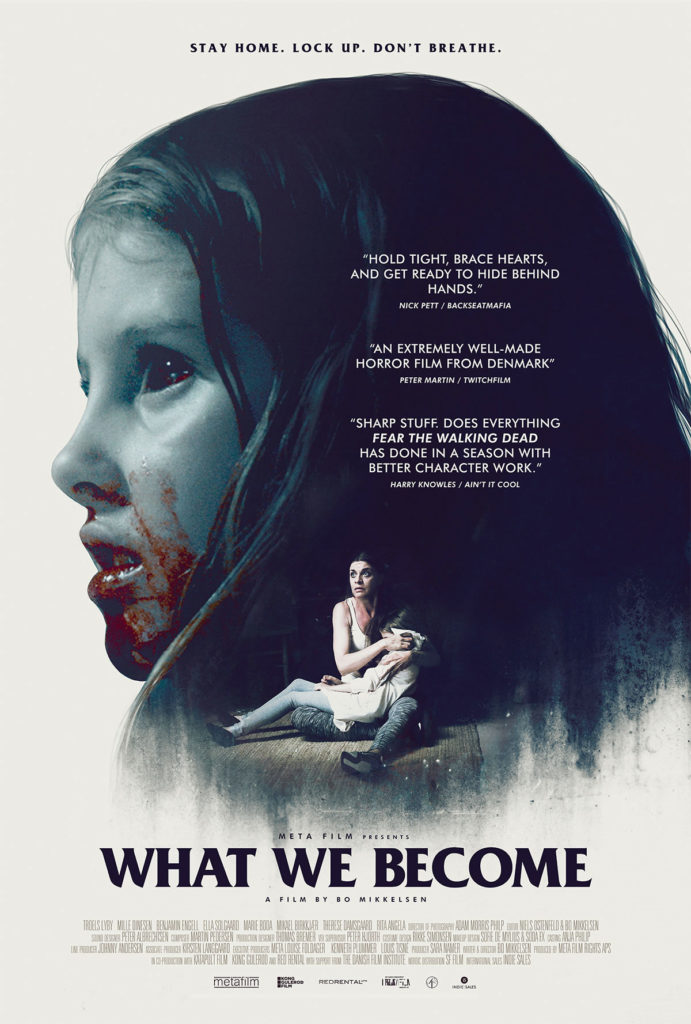If a viewer happens to be in the mood for something post-apocalyptic from the horror genre, a good zombie flick can be a fine way to go. But there are so many zombie flicks now that it’s hard to pick out something with enough originality to make it worth one’s while. Even good zombie flicks sometimes only offer token revisions to the subgenre’s many, many tropes. That’s why I enjoy it all the more when I come across something like What We Become.
From Denmark, What We Become is writer/director Bo Mikkelson’s first feature film. Middle-aged father Dino (Troels Lyby) and his family, wife Pernille (Mille Dinesen), rebellious teen son Gustav (Benjamin Engell), and young daughter Maj (Ella Solgaard), are enjoying a summer in the suburbs. They aren’t a picture perfect family. They have flaws, just like any other family. Dino is a bit of a weak-kneed flake, while Pernille seems to be making an effort to solve problems in the marriage that Dino is oblivious to. Maj is too young to notice any dysfunction, but Gustav has reached the age where being in the presence of his parents is barely tolerable. In fact, if one were to look too deeply at this film’s characterizations, it’s possible to come to the conclusion that this film is told from Gustav’s point of view. Dino may be the head of the family, but Gustav is the film’s main protagonist. Like Holden Caulfield, everyone in Gustav’s world, except the new cutie who just moved in across the street, Sonja (Marie Hammer Boda), is a clueless asshole in some form or another.
The idyll of the ’burbs is disrupted by news that an unknown pathogen is sweeping through the area. After some introductory character development and plot setup, the suburb is placed under a government quarantine. This action catches Gustav and everyone else by surprise. Other than some vague news reports, no one in the neighborhood  knew how bad things were getting until soldiers in gas masks began prowling the streets. The audience is also just as much in the dark. To this point, there hasn’t been a single zombie shown on screen. The few instances of violence there has been are only alluded to. In fact, if I hadn’t read a short synopsis before I watched this film, I wouldn’t have even known this was a zombie flick. So, with this review, I seem to have also spoiled the film’s big reveal. It’s probably better that way.
knew how bad things were getting until soldiers in gas masks began prowling the streets. The audience is also just as much in the dark. To this point, there hasn’t been a single zombie shown on screen. The few instances of violence there has been are only alluded to. In fact, if I hadn’t read a short synopsis before I watched this film, I wouldn’t have even known this was a zombie flick. So, with this review, I seem to have also spoiled the film’s big reveal. It’s probably better that way.
The act where the neighborhood is under quarantine is the best sequence in the film. The characters suffer as they are held prisoner in their own homes, dependent for sustenance on meager rations left by the soldiers. Meanwhile, the military has draped black tarps over the houses, ostensibly to prevent the spread of infection, but more ominously, to prevent the residents from seeing what is happening in the neighborhood. Outside the soldiers are going door to door, and it seems some people are being removed from their homes. This act is what makes the film worthwhile for me. It doesn’t rely on the undead for tension. The interplay between the residents, and between the residents and the soldiers, is enough. Because of reasons that are very understandable, the soldiers are being harsh with the residents, but nothing like this would ever seem justifiable were one on the receiving end. But, this is a zombie flick, so eventually the soldiers will have to be replaced as the bad guys.
After Gustav sneaks out of his house and makes some very poor decisions, the zombies are let loose, and it is here where the film becomes more conventional zombie fare. The good news is Mikkelson knows how to direct horror. There are a couple jump scares here and there, but they weren’t made on the cheap. A little bit of thought on Mikkelson’s part meant they fit right into the natural flow of the film.
The final act is frantic, as all the remaining cast members try their best to survive. Mikkelson kept the film’s location confined enough that there is no guarantee that surviving the assault is a good thing. Early in the film, nothing exists outside of the suburb. By this final act, there is little outside of the enshrouded windows of a house. Every zombie flick has a final act where it all goes wrong for the protagonists. This climax was more satisfying than most, and that includes a couple of Romero flicks.
Zombie flicks have now been a film staple for some six decades. The term ‘zombie’ evokes a narrow definition that has led to stagnation, as more and more of these films get made. But What We Become shows that given the right idea and execution, there are still plenty of good zombie films to be made.
